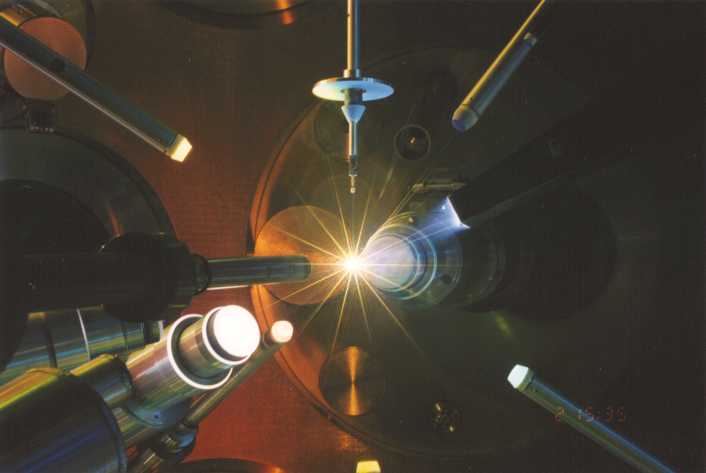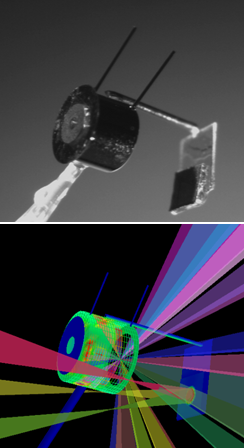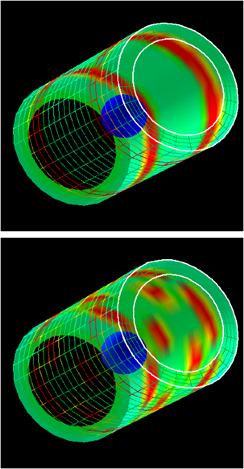|
Inertial Confinement Fusion, in its most general definition, is the process of compressing and heating hydrogen isotopes to the extent that the nuclei can overcome the coulomb barrier (i.e. the electrostatic repulsion of like-charges) and fuse together (into helium) releasing huge amounts of energy. It is distinct from magnetic fusion, in which a low density plasma is heated and then confined using magnetic fields as the fusion reactions progress. In inertial confinement fusion (ICF), the compression and heating of the fuel is accomplished by depositing massive amounts of energy on the outside of a solid, spherical fuel capsule. As this energy is deposited in a thin layer on the outside of the capsule, that layer heats up and the over-pressure in this narrow region leads to both the ablation of material outward and the launching of a shock wave inward. If the characteristics of the ablation and the shock wave(s) are controlled precisely, then a small region in the interior of the fuel capsule can enter the region of temperature-column density parameter space in which fusion reactions efficiently occur. The fusion energy from such an initial "hot spot" is then deposited in the rest of the capsule, generating further reactions. This process is termed "ignition" and has not yet been achieved, but should be in the National Ignition Facility (NIF), currently being built at Livermore National Lab. It is the inward directed momentum of the implosion - the inertia of the core of the fuel capsule - that keeps the fuel confined for the roughly 1 ns required for the fusion reactions to proceed. In "indirect-drive" ICF the energy source that drives the ablation and compression is radiation (X-rays) that is produced by the conversion of a non-thermal, directed energy source (lasers or particle beams) into thermal radiation inside a high-opacity enclosure, referred to as a "hohlraum." |

|
An X-ray image of a hohlraum being irradiated by 10 laser beams at the old NOVA laser at Livermore. Note the ten laser hot spots which are generated when the laser beams hit the inside wall of the hohlraum (outlined in white). The laser beams are drawn in as the bluish-white lines, and the white thing at the top is a stalk that holds the hohlraum in place during the experimental shot.
|
|
We have used the now-closed NOVA laser facility at Livermore, as well as the 60-beam OMEGA laser facility at the University of Rochester, for ICF experiments. |
|
This is the interior of the OMEGA target chamber at the Laboratory for Laser Energetics at the University of Rochester during a laser shot.
|

|
|
Our understanding of, and ability to control, the nature of the coupling of the hohlraum radiation field to the outer layer of the fuel capsule (the "ablator") is a crucial factor in producing an efficient implosion and, ultimately, achieving ignition. To this end, we have developed X-ray spectroscopic techniques for diagnosing the time-dependent ionization state in a thin tracer layer deposited on the interior of a sample of ablator material exposed to a hohlraum radiation field. Our April 2000 campaign included several shots for which we were able to measure a delay in the turn-on time of the K-alpha absorption signals between germanium doped plastic ablator samples and undoped samples. An overview of the project and context is given in this presentation (pdf). The results have been published in "Tracer spectroscopy diagnostics of doped ablators in inertial confinement fusion experiments on OMEGA" by Cohen, MacFarlane, Jaanimagi, Landen, Haynes, Conners, Penrose, & Shupe, Physics of Plasmas, 11, 2702 (2004). |

|
The upper image on the left is a photograph of one of our halfraum targets from our OMEGA campaign. The stalk that holds the halfraum can be seen in the lower left corner of the image. The ablator sample is secured on the left end of the halfraum under a gold washer. The wires on the barrel of the halfraum are used for positioning within the target chamber. A backlighter foil is hung off of the open end of the halfraum, and is visible in the lower right corner of the image. The foil is mounted on the lead-doped plastic (to facilitate viewing the halfraum while positioning it). The lower panel shows our view factor modeling of the halfraum as it's irradiated by 15 beams, with three additional beams on the backlighter foil. The color coding shows emission temperatures of each surface element. The output of this simulation is used as input to a hydrodynamics simulation. These simulations are post-processed in order to produce model absorption spectra, which we ultimately compare to data.
|
|
We later did a detailed exploration of the effects of beam pointing and hohlraum geometry on radiation conditions inside hohlraums. We published this study in "Numerical modeling of hohlraum radiation conditions" by Cohen, Landen, & MacFarlane, Physics of Plasmas, 12, 2703 (2005). |
|
From Cohen, Landen, & MacFarlane: Emission temperatures are compared for two different beam pointings in a hohlraum with a spherical capsule. The view is from the DANTE (absolutely calibrated soft x-ray detector) position; note that the pointing depicted in the bottom frame puts more hot spot are in the DANTE view (through the LEH, which is outlined in white).
|

|
|
Return to David's Home Page |
David Cohen: cohen -at- astro -dot- swarthmore -dot- edu
Last modified: June 8, 2008